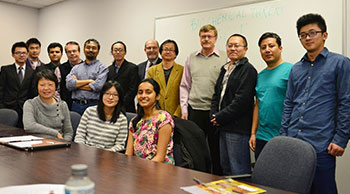UH Gets Homeland Security Funding to Fight Bioterror
Focus of Research on Making Biochemical Threat Detection Economically Sustainable
 The University of Houston received funding from the U.S. Department of Homeland Security
(DHS) to conduct research on making biochemical threat detection economically sustainable.
The University of Houston received funding from the U.S. Department of Homeland Security
(DHS) to conduct research on making biochemical threat detection economically sustainable.
Awarded to the UH Department of Computer Science, the contract is part of the SenseNet program, which is funded by the U.S. Department of the Interior on behalf of the DHS Science and Technology Directorate. The goal of this award is to design and implement faster, more autonomous, less expensive bio-threat detection systems. Members of the Department of Earth and Atmospheric Sciences are also part of the project team.
“We will explore both technical and market-based innovations to lower the cost of threat-sensing solutions,” said Christoph F. Eick, principal investigator (PI) and associate professor of computer science in the College of Natural Sciences and Mathematics.
 The goal of the SenseNet project is to develop multi-tiered, multi-component aerosol
detection sensor systems, where biological and chemical detection sensors leverage
new commercial systems. The hope is that the resultant architecture will make it possible
to map contamination in real time, convey information to multiple layers of decision
makers and operate in a cost-effective manner. This research is aimed at enabling
an alternative, market-based approach to BioWatch, which is the federal government
program created in 2001 to detect biological attacks through a network of sensors.
The goal of the SenseNet project is to develop multi-tiered, multi-component aerosol
detection sensor systems, where biological and chemical detection sensors leverage
new commercial systems. The hope is that the resultant architecture will make it possible
to map contamination in real time, convey information to multiple layers of decision
makers and operate in a cost-effective manner. This research is aimed at enabling
an alternative, market-based approach to BioWatch, which is the federal government
program created in 2001 to detect biological attacks through a network of sensors.
This project’s modeling component development will be done by Yunsoo Choi and Anirban Roy from the Department of Earth and Atmospheric Sciences. They will use an existing modeling framework, UH Air Quality Forecasting system (http://spock.geosc.uh.edu), to provide an early warning system for threat detection from an aerosol release from a chemical/biological warfare source. The spread of the contaminant in space and time could then be computed to forewarn communities in the path of the contaminant plume. The early warning system uses a 3-D numerical air quality model. It uses the magnitude of the difference between the numerically modeled and in-situ observed values to identify a significant aerosol release. Next, the location of the source is identified using a back-trajectory model, and ground in-situ concentrations measured. These concentration values are used to make emissions estimates to feed a plume dispersion model to predict the path of the toxic plume.
The detection systems the researchers plan to develop will employ state-of-the-art cloud computing, sensor networks, modelling, data analytics and alarm management technologies. The research seeks to widen the customer base for environmental sensors and threat detection services. In addition to acting as an early biochemical threat detection system, these sensors are being used to provide better security, energy usage, air quality and early warning capabilities. Consequently, the project will investigate the use of low-cost biological and chemical aerosol and particle sensors that can be used to provide benefits not only to the DHS, but also to other entities, such as universities, shopping malls and airports.
The project will be conducted in three phases with a total planned budget of $1.8 million for a three-year period. The research team is currently working on Phase I for which they received the initial $480,000 to design the SenseNet computational infrastructure. Phases II and III center on the implementation and commercialization of the infrastructure.
“The research team is committed to tackling critical scientific challenges that are of great public interests to make our society safer, more secure and create an environment where the community can thrive, prosper and learn from past experience,” Eick said. “In the long run, our goal is to make communities more resilient in dealing with environmental and other threats. This is an area that has recently become a major focus of research in the Department of Computer Science.”
The project, titled “Networking and Computational Infrastructure for Collecting and Interpreting Sensor Data with Respect to Aerosolized Chemical and Biological Threats,” will be a multidisciplinary effort. In addition to Eick, who is the PI, the co-PIs are assistant professors of computer science Larry Shi and Omprakash Gnawali and assistant professor in the Department of Earth and Atmospheric Sciences Yunsoo Choi. Senior personnel are executive professor Alan Lish from the Bauer College of Business, postdoctoral fellow Anirban Roy from the Department of Earth and Atmospheric Sciences, research associate Lei Xu and project manager Yang Lu from the Department of Computer Science, and assistant director of facilities management Michael Burriello from the UH Central Plant.
Students also will have an opportunity to contribute. Offering an interdisciplinary, hands-on project, this research will give students an opportunity to deploy technologies that solve important societal problems, as well as obtain experience in dealing with government agencies. This will provide them with skills that will serve them well in finding jobs in industry and research labs.
The project is managed by the Chemical and Biological Defense Division of the DHS. This division’s mission is to strengthen the nation’s security and resiliency against chemical and biological threats through improved threat awareness and advanced surveillance, detection and protective countermeasures.
- Lisa Merkl, UH Media Relations